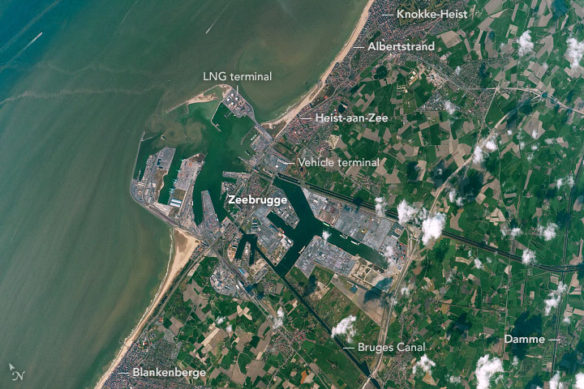
Astronaut photograph ISS051-E-13055 was acquired on April 13, 2017.
By Justin Wilkinson, Texas State University, JETS Contract at NASA-JSC;
Looking down on the narrow seas between Europe and England, an astronaut took this photograph of the small town of Zeebrugge, one of Europe’s most important modern ports. This Belgian town has just 4,000 inhabitants, but it takes 11,000 people to operate the port, so workers stream in from neighboring coastal towns such as Knokke-Heist, Heist-aan-Zee, and Blankenberge.
Zeebrugge is a town of superlatives. It is the world’s largest port for the import and export of new vehicles, with more than 1.6 million handled in 2010. Zeebrugge is also the site of Europe’s largest liquid natural gas (LNG) terminal, receiving the gas via an undersea pipeline from the North Sea.
The port at Zeebrugge accommodates “ultra-large” container ships, so it is one of the most important European hubs for containerized cargo. The most important function of the port is intense “RoRo traffic” (roll-on roll-off) between cities on the Continent, Great Britain, Scandinavia, and Southern Europe. The port handles more than 2.5 million standard containers (TEUs) and 50 million tonnes of cargo each year.
Being close to the United Kingdom, the coastal town also functions as a passenger ferry terminal. It attracts tourists to its cruise ships as well as its beaches, which are well developed north of the harbor in Albertstrand. Zeebrugge is also Belgium’s most important fishing port, and its wholesale fish market is one of the largest in Europe.
Hundreds of years ago, an arm of the sea extended well inland as far as the village of Damme, which acted as a port for centuries. When this inlet silted up, Zeebrugge became the port for the famous historical inland city of Bruges (just outside the lower right of the photo) with which it is still connected by a straight canal. Zeebrugge means Bruges by the sea.
Original Article; NASA / Earth Observatory (08-21-2017)
Deep-Sea Ports Construction Cause Coastal Erosion, Bangkok Post (01-12-2012)
Destructive coastal erosion along southern shorelines battered by recent storms could be the result of deep-sea port construction, villagers say, leaving them in fear of more beaches disappearing…
African Ports Scramble for Land to Expand as Demand Rises; JOC (07-28-2015)
Experts All Set For In-Depth Study Of Beach Erosion, Times Of India (02-17-2014)
A team of oceanography experts has submitted a report on the preliminary causes identified for the ongoing coastal erosion affecting the Port’s region on the AP littoral. Two main reasons have been identified…
The Prevention and Control of Shipping and Port Emissions in China, NRDC; (10-28-2014)
China is home to seven of the world’s ten busiest container ports. About 26 percent of the world’s containers pass through the top ten Chinese ports every year. Every ship and truck brings pollution along with its cargo, and China is paying a high price for pollution from shipping. A NRDC new report…
Worldwide Ship Traffic Up 300 Percent Since 1992, AGU (11-29-2014)
Thousands Of Containers Fall Off Ships Every Year. What Happens To Them? Huffington Green (07-17-2014)
It is estimated that thousands of containers are lost every year along international shipping routes due to big waves or wind gusts. Sometimes they wash up on shore, but what happens to the containers that land at the bottom of the sea? No one really knew.
Sea Traffic Pollutes Our Lungs More Than Previously Thought, Science Daily (11-20-2015)
New data show that the air along the coasts is full of hazardous nanoparticles from sea traffic. Almost half of the measured particles stem from sea traffic emissions, while the rest is deemed to be mainly from cars but also industries and natural particles from the sea…
Study: Why Blue Whales Can’t Avoid Barges, Ocean Liners, Huffington Green (05-06-2015)
Super-sized ships: How big can they get? Independent UK (10-20-2014)
Despite the physical limits and risks, ships of more than 450m are anticipated within the next five years…
Shipping Superhighways; NASA (04-06-2015)
The oceans may be vast, yet they still can grow crowded. Some congested areas have enough ship traffic that the International Maritime Organization (IMO) and other groups maintain traffic separation schemes—the equivalent of highways for ships—to reduce the risk of collisions…
“FREIGHTENED – The Real Price of Shipping,” a movie by multi award-winning filmmaker Denis Delestrac-©-2016; (03-31-2016)
90% of the goods we consume in the West are manufactured in far-off lands and brought to us by ship. The cargo shipping industry is a key player in world economy and forms the basis of our very model of modern civilisation; without it, it would be impossible to fulfil the ever-increasing demands of our societies. Yet the functioning and regulations of this business remain largely obscure to many, and its hidden costs affect us all. Due to their size, freight ships no longer fit in traditional city harbours; they have moved out of the public’s eye, behind barriers and check points…
Breaking Bad on the Beach, NASA / Earth Observatory (09-28-2014)
Tens of thousands of ships ply the world’s oceans, bays, and rivers. But what happens when those ships have become too old or too expensive to operate? In most cases, they end up on the shores of Asia…literally.









